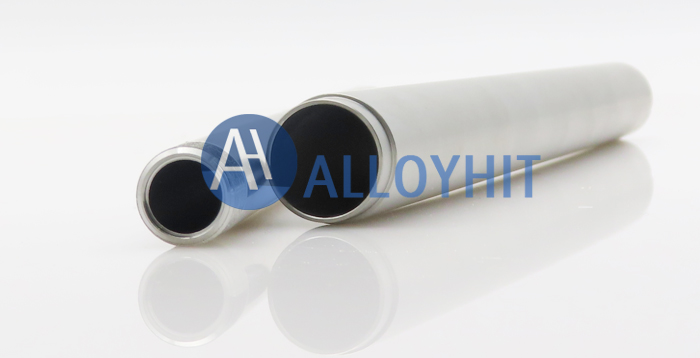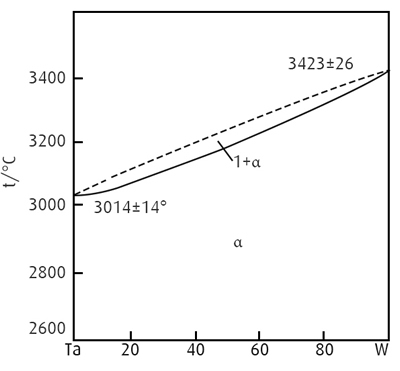Ta10W
Tantalum-based alloys have the characteristics of high temperature resistance, high strength and good chemical stability, and are indispensable materials in the fields of aviation industry, atomic energy industry and high temperature technology.
The physical properties of Tantalum 10 Tungsten alloy make it very valuable in many high-tech applications.
Physical properties of Tantalum 10 Tungsten alloy
High density: Tantalum 10 Tungsten alloy has a density of about 16.5 g/cm3, which has high quality and strength, and is suitable for applications that require a balance of weight and strength.
High melting point: The melting point of Tantalum is about 3017°C, and the melting point of Tungsten is about 3422°C, so Tantalum 10 Tungsten alloy has an extremely high melting point, which is suitable for use in extreme temperature environments.
Hardness: Tantalum 10 Tungsten alloy exhibits high hardness, especially under high temperature conditions, and can resist wear and deformation, making it suitable for manufacturing wear-resistant parts.
Electrical and Thermal Conductivity of Tantalum 10 Tungsten
Electrical conductivity: Both tantalum and tungsten are good conductors of electricity, and Tantalum 10 Tungsten alloy also maintains good electrical conductivity, making it suitable for electronic components.
Thermal conductivity: Tungsten has excellent thermal conductivity, while tantalum has relatively low thermal conductivity, but Tantalum 10 Tungsten alloy as a whole can still effectively conduct heat.
Mechanical properties of Tantalum 10 Tungsten alloy
Strength:
Tantalum 10 Tungsten alloy has high tensile strength and yield strength, and can withstand large loads and pressures.
Ductility:
Despite its high hardness, Tantalum 10 Tungsten alloy still has a certain degree of ductility and can be processed and formed.
Tensile Strength:
The tensile strength of Tantalum 10 Tungsten alloy is usually between 800-1200 MPa, and the specific value depends on the alloy's processing state and heat treatment process.
Yield Strength:
The yield strength of Tantalum 10 Tungsten alloy is generally in the range of 600-900 MPa, showing good load-bearing capacity.
Ductility:
Tantalum 10 Tungsten alloy has high ductility, usually between 10% - 20%, which enables it to withstand large deformations during processing without breaking easily.
Hardness:
Tantalum 10 Tungsten alloy has a high hardness, usually above 200 HV (Vickers hardness), which makes it perform well under wear and impact conditions.
High Temperature Resistance:
Tantalum 10 Tungsten alloy can still maintain good mechanical properties in high temperature environments and is suitable for high temperature applications such as aerospace and nuclear reactor components.
Corrosion resistance:
Tantalum itself has excellent corrosion resistance, and the addition of tungsten further enhances the alloy's resistance to chemical corrosion.
| Mechanical properties of Ta10W(21℃) | ||||
| Elastic Modulus /Mpa | Yield Strength /Mpa | Tensile Strength /Mpa | Elongation /% | Material Form |
| 203890 | 471 | 562 | 25 | various types |
Heat treatment methods for Tantalum 10 Tungsten alloy
The heat treatment methods for Tantalum 10 Tungsten alloy mainly include multiple steps aimed at improving its mechanical properties and microstructure. The following are common heat treatment methods:
Forging:
Before heat treatment, Tantalum 10 Tungsten alloy is usually forged to improve its density and uniformity. During the forging process, the alloy is heated to a certain temperature and then plastically deformed.
First heat treatment:
After forging, Tantalum 10 Tungsten alloy needs to undergo the first heat treatment, usually between 1000℃ and 1500℃, and the holding time is 60 minutes to 150 minutes. This process helps to eliminate the residual stress generated during the forging process and improve the microstructure of the material.
Second heat treatment:
After the first heat treatment, Tantalum 10 Tungsten alloy may undergo a second heat treatment, with the temperature range of 1000℃ to 1500℃ and the same time as the first time. This stage further optimizes the properties of the material and makes it more suitable for subsequent processing.
Vacuum annealing:
Tantalum 10 Tungsten alloy is annealed in a vacuum environment, which can effectively reduce the risk of oxidation and decarburization. It is usually kept at 1500℃ for 150 minutes and then cooled with the furnace to ensure the purity and performance of the material.
Cooling:
After all heat treatment steps, Tantalum 10 Tungsten alloy should be cooled slowly to avoid internal stress concentration caused by a sudden drop in temperature.

Other considerations
Processing rate: During forging and rolling, the total processing rate is usually controlled between 75% and 85% to ensure the mechanical properties and processing feasibility of the material.
Pickling: After certain heat treatment steps, pickling may be required to remove surface oxides and impurities, thereby improving the quality of subsequent processing.
Through these heat treatment methods, Tantalum 10 Tungsten alloy can obtain excellent mechanical properties and stable microstructure, making it suitable for demanding applications.
Physical Properties of Ta10W
| Grade | Composition | Physical Properties | |||||
| Density /g.cm³ |
Melting Point /℃ |
Coefficient of Linear Expansion /10K | Recrystallization Temperature /℃ | Annealing Temperature /℃ |
Extensional Brittle Transition Temperature /℃ | ||
| Ta10W | Ta10W-0.03Mo-0.1Nb | 16.84 | 3033 | 3.74(1649℃) | 1316~1538 | 1203~1232 | -196 |
Forms of Ta10W
Features of Ta10W
High temperature and high strength, used in the aerospace industry.
Corrosion resistance
In almost any environment, tantalum quickly forms a surface oxide film that tightly wraps the metal substrate. This oxide film is extremely thin and dense, impermeable to almost all media, and can heal itself once it is damaged. Thanks to such a protective film, tantalum has extremely excellent corrosion resistance properties.
Adding a certain amount of tungsten element to tantalum can improve the corrosion resistance of metal tantalum, such as Ta10W.
Phase Diagrams of Ta10W

Processing method of Ta10W
Powder metallurgy method of vacuum high temperature sintering, electron beam furnace (EB), vacuum consumable arc furnace (VAR) vacuum melting method are ideal common methods for preparing Ta10W ingot blanks.
Rotary forging is one of the main means of tungsten rod (rod) production.
Process flow of Ta10W
The process of swaging sintered tungsten and its alloy strips into rod (rod) material is called swaging process, and the process is as follows:

Strategies for Corresponding Oxidation
The surface-purified Ta10W will oxidize as the temperature increases, and the surface color will also change. Heating at 500 ℃ for a short time produces a gray-black oxide film, and prolonging the holding time, the oxide film becomes white. The oxide film formed at low temperature has a protective effect, which slows down the oxidation rate. At high temperature, the protective oxide film is destroyed and the oxidation rate is accelerated..
Therefore, Ta10W tubes, rods, and wires can be directly cold processed at room temperature, and hot processing must be coated with an anti-oxidation layer, or in a vacuum state or in an inert gas protective atmosphere (usually argon).
Application of Ta10W
Due to the advantages of high melting point, corrosion resistance and good cold working performance, Ta10W has been more and more widely used in chemical, aerospace, electronics and other industrial fields and medical treatment.
Chemistry: As an excellent corrosion-resistant material, its corrosion resistance is better than that of titanium zirconium. In sulfuric acid, nitric acid, hydrochloric acid, aqua regia, perchloric acid, chloride, bromide, hydrobromic acid, phosphoric acid; in nitrogen oxides, chlorine oxides, hypochlorous acid, organic acids (including chloroacetic acid) ; Ta10W has very good corrosion resistance in hydrogen peroxide and all salts whose hydrolysis reaction does not produce free hydrofluoric acid or strong base.
Aerospace industry: Ta10W rods can be used as heat-resistant and high-strength materials for supersonic aircraft, rockets, and missiles, as well as control and adjustment parts. It can be used at high temperature of 2500℃.

High temperature treatment: it is the main material for high temperature vacuum furnace above 1600℃. In high temperature vacuum furnace, Ta10W can be used as supporting accessories, heaters, heat shields, etc. It is more stable and easier to process than tungsten and molybdenum.

 +86 13120915623
+86 13120915623